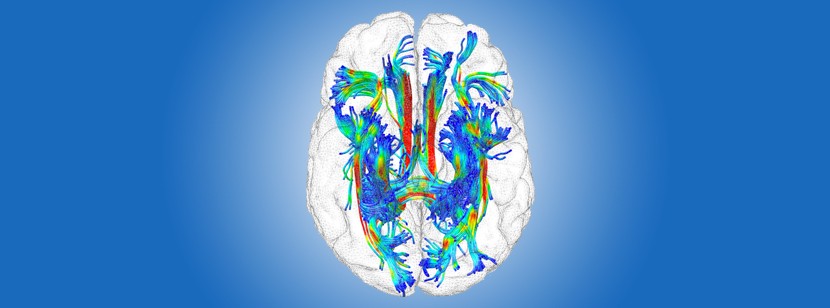The research collaboration between Professor Harald Hampel (AXA Research Fund and UPMC Chair on Alzheimer’s disease) and Dr. Michel Thiebaut de Schotten (CR2 CNRS – CRInstitut du Cerveau – ICM), both researchers at the Institut du Cerveau et de la Moelle épinière – Institut du Cerveau – ICM – Brain and Spine Institute, is currently highlighted on the cover of the prestigious international journal Alzheimer’s & Dementia (A & D – September 2014 – Volume 10, issue 5). This cover relies on Prof. Harald Hampel’s international expertise and reputation in the field of Alzheimer’s disease, particularly neuroimaging and biomarker research and that of Dr. Michel Thiebaut de Schotten in structural connectivity. The presence of Prof. Hampel and Dr. Thiebaut de Schotten in the spotlight illustrates their current research breakthrough scientific projects on early biomarkers of Alzheimer’s disease, such as brain connectivity measures, as presented in this A&D cover.
The illustration in cover of A&D’s September issue, provided courtesy of Dr. Thiebaut de Schotten and Prof. Hampel, represents the white matter tracts emerging and ending in the hippocampus. The hippocampus is a brain region involved in memory and spatial navigation, functions that are affected in people with Alzheimer’s disease (AD). The color code correspond to the white matter integrity – density scale (e.g., red=very high, orange=high, yellow=medium … violet=low). Such a marker – 3D architecture, layout and density of white matter tracts – may be key in the identification of early changes in neurodegenerative diseases such as AD.
Teams of Prof. Hampel at at the Institut du Cerveau – ICM and at the IM2A (Institut de la Mémoire et de la Maladie d’Alzheimer – Institute of Memory and Alzheimer’s disease) and of Dr. Thiebaut de Schotten at the Institut du Cerveau – ICM, collaborating on the Pitié-Salpêtrière University hospital site, are using recent cutting edge neuroimaging methodologies to discover novel footprints as an indication of impaired anatomical neural networks at various stages of AD, which have the potential to model and predict the conversion from the silent stage of “cognitive normality” (prodromal asymptomatic stage of the disease) to the symptomatic stages of AD. Prof. Hampel, Dr. Thiebaut de Schotten and their teams put much hope in these advancing neuroimaging technologies. The neural network signature established by Prof. Hampel and Dr. Thiebaut de Schotten of a specific patient at a given disease time point may provide breakthrough options to support early detection and effective AD therapy.

Illustration – credit © Michel Thiebaut (Institut du Cerveau – ICM) and Harald Hampel (IM2A – Institut du Cerveau – ICM)
About Authors:
Professor Harald Hampel, Excellence Chair at Sorbonne Universities, Pierre and Marie Curie University in Paris, France, became founding director of the Alzheimer Memorial Center at Munich University before being appointed professor and chair of psychiatry at Trinity College, Dublin. In 2010, he was appointed as professor & chair of psychiatry at the University of Frankfurt and in 2013 as professor and AXA Research Fund Chair on “Anticipating Alzheimer’s disease” at Sorbonne Universities, Pierre and Marie Curie University, Neurology Department, Institut de la Mémoire et de la Maladie d’Alzheimer – IM2A (Hôpital de la Salpêtrière, Paris) and the Institut du Cerveau – ICM. Author of more than 550 peer-reviewed research papers and 8 books, Prof. Harald Hampel won multiple awards for his research focusing on brain health & disease, biomarker and therapy discovery in Alzheimer’s disease. His reputation and expertise as a worldwide opinion leader in the field of Alzheimer’s disease are well established and recognized.
Dr. Michel Thiebaut is CNRS researcher (CR2) in the “FRONTLAB” team led by Professors Bruno Dubois and Richard Lévy, which is part of the “Cognition, Emotion, Action” Axe at the Institut du Cerveau – ICM – Institut du Cerveau et de la Moelle épinière – Brain and Spine Institute. Amongst other, he works on functional imaging (fMRI) to study the activation of the brain during behavioral tasks and anatomical imaging to detect correlations between lesions in the brain and mental functions and the fibers (tracts) that connect different parts of the brain. He is the co-author of “Atlas of Human Brain Connections”, published in June 2012.
Journal:
Alzheimer’s & Dementia – The Journal of Alzheimer’s Association – Volume 10, Issue 5, Septembre 2014







